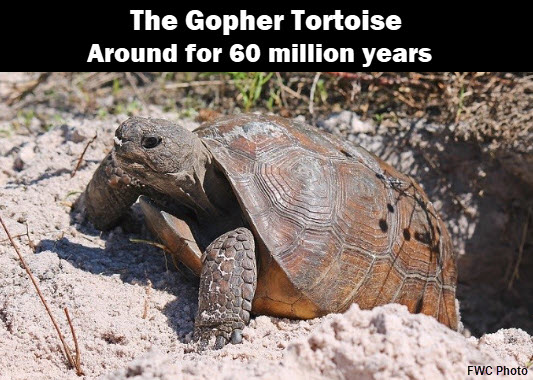FWC Announces a New Way to Report Gopher Tortoise Sightings: "You Can Help Conserver One of the Oldest Creatures on the Planet"
Posted September 9, 2020 05:15 pm

FLORIDA – The Florida Fish and Wildlife Conservation Commission (FWC) is launching a new interactive web application designed to provide biologists with thorough and reliable data, and promote science-based gopher tortoise conservation efforts. The new system will replace the Florida Gopher Tortoise smartphone app, which will be decommissioned Sept. 8.
The new web application is user-friendly and is designed to function on any device. To report a tortoise sighting or notify the FWC of a sick, injured or dead tortoise, simply visit MyFWC.com/GopherTortoise and click on the button that reads “Report Gopher Tortoise Sightings.” There, you can also view an interactive map, which features user-submitted photos and locations of tortoise sightings throughout the state.
What is the gopher tortoise?
(See
National Geographic – includes links)
The gopher tortoise earned its name because it digs deep burrows—like a gopher. This large tortoise, which can weigh up to 15 pounds, has scaly, shovel-like front legs that are specialized for digging. It lives in the southeastern United States and is the only land tortoise native to the area. It became the official state tortoise of Florida in 2008. The gopher tortoise is a keystone species, meaning that it’s very important to the health of the ecosystem it inhabits. Gopher tortoise burrows provide shelter to hundreds of different animals, ranging from frogs to owls and even endangered indigo snakes.
Habitat and diet
The gopher tortoise is mainly concentrated
in Florida
This tortoise is found from Louisiana to South Carolina, but it's mainly concentrated in Florida. Though it’s most active when the weather is warm, the gopher tortoise spends much of its life inside burrows to avoid predators and extreme weather. These burrows maintain stable temperature and humidity levels throughout the year. A gopher tortoise will dig several burrows throughout its lifetime, with males in Florida known to dig up to 35. The dry and sandy soil needed to dig the burrows is found on sandhills under dry oak and longleaf pine trees. The gopher tortoise will even use well-drained soil in old pastures and roadsides when necessary.
Longleaf pine forests and coastal dunes provide optimal conditions for the tortoise. It needs a habitat with trees—but not too many. Otherwise, sunlight cannot filter through to nourish the low-growing plants that are staples of the tortoise’s diet. It also eats berries, flowers, grass, and mushrooms, as well as apples and cactus pads. The gopher tortoise helps the plants it eats by spreading their seeds through droppings. As an opportunistic eater, the tortoise will also consume dead crabs and insects. The gopher tortoise gets plenty of water from the plants it eats, so rarely needs to seek out separate water sources.
Behavior and reproduction
The gopher tortoise prefers leading a solitary life – except during mating season. That’s why you probably won’t find more than one gopher tortoise in a burrow, unless you come across a nest of hatchlings. Females lay their eggs near the entrance of the burrow, and many are eaten by coyotes, raccoons, and eagles passing by unguarded nests. Gopher tortoise eggs take 80 to 110 days to hatch, and babies are independent from birth – they receive no parental care.
The gopher tortoise can live for 60 years in the wild. It can take up to 21 years for an individual to reach maturity, at which point, it’s ready to mate.
Though gopher tortoises are normally docile, males become aggressive when fighting over a female and will push and ram into each other.
There are still many unknowns about how an individual finds a mate.
Threats to survival: vulnerable to extinction
The gopher tortoise is classified as vulnerable to extinction by the International Union for the Conservation of Nature. Scientists estimate that there are currently 700,000 gopher tortoises left in the wild, perhaps less than a third of their numbers a century ago.
The main threat the species faces is habitat loss. Urbanization continues to fragment and destroy longleaf forests. At the current rate of development, the gopher tortoise could lose 20 percent of its habitat within the next 40 years.
Female tortoises are also at risk of being hit by cars while searching for suitable locations to build their nests. All of these threats are exacerbated by how long it takes the tortoise to reach sexual maturity—slowing the production of new offspring—and the low survival rate of its eggs.
Conservation
FWC’s Michelina Dziadzio, monitoring coordinator for the Wildlife Diversity Conservation Section, said, “We appreciate the thousands of citizen scientists who have reported gopher tortoise sightings using our original Florida Gopher Tortoise app over the years. These citizen scientists have helped the FWC enhance gopher tortoise conservation and we’re excited for their continued participation using the new web app.”
For more information about gopher tortoises, also visit MyFWC.com/GopherTortoise.
